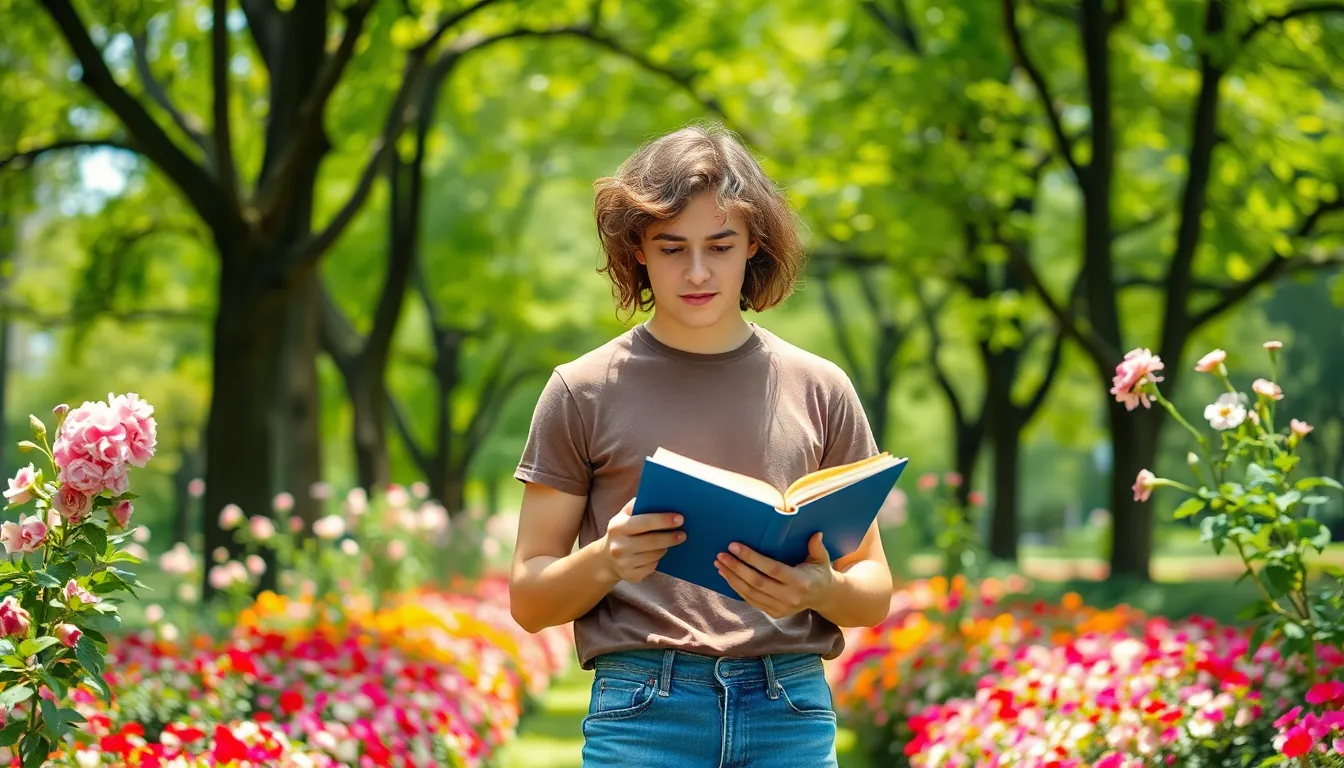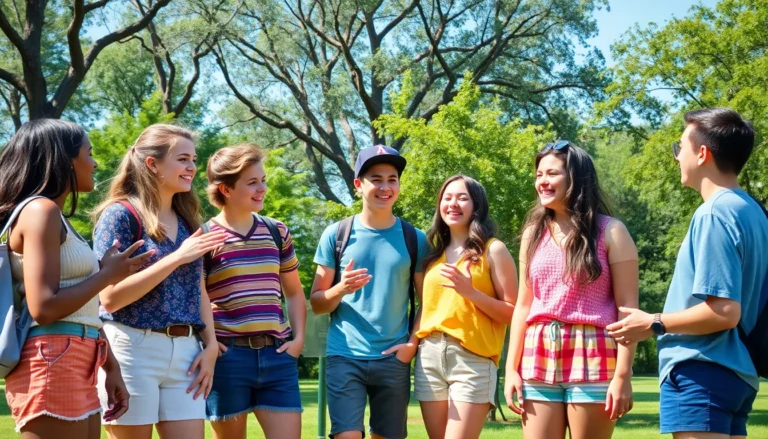Teenagers have a unique way of expressing themselves, often through the vibrant and chaotic world of poetry. These young wordsmiths capture the essence of their experiences, emotions, and dreams in ways that can make even the most stoic adult crack a smile. Who knew angst could be so entertaining?
From the trials of high school drama to the sweet sting of first love, teenage poetry offers a glimpse into a world bursting with creativity and raw emotion. It’s not just about rhymes and rhythms; it’s a powerful outlet that can resonate with anyone who’s ever felt a little misunderstood. So, whether you’re a parent, teacher, or just a curious reader, diving into the realm of teenage poetry might just remind you of the wild ride that is adolescence—and you might find yourself laughing, crying, or even nodding in agreement along the way.
Table of Contents
ToggleOverview of Teenagers Poetry
Teenage poetry serves as an influential medium for self-expression. Young poets communicate their thoughts and feelings through verses, capturing the complexity of adolescence. Emotional experiences dominate the subject matter, addressing themes like identity, love, friendship, and societal pressures.
High school settings often inspire these works, as students navigate the challenges of peer relationships and academic demands. Creative formats can vary, including free verse, sonnets, and spoken word, allowing teens to explore different styles.
Expressive language flows within these poems, often featuring vivid imagery and strong metaphors. Such techniques resonate deeply with both the creators and their audiences. Unfiltered honesty characterizes youth writing, allowing genuine emotions to shine through.
Poetry slams and open mic nights contribute to the popularity of this art form, providing platforms where teens can share their work publicly. These events foster a sense of community, encouraging collaboration and support among young poets.
Schools play a significant role in promoting teenage poetry. English classes often include assignments that encourage creative writing, exposing students to historical and contemporary poets. Resources like anthologies and online forums extend the reach of their voices, connecting young writers with a broader audience.
Understanding the importance of teenage poetry highlights its role in shaping self-identity. As they navigate their formative years, these poets document their journeys, reflecting both personal growth and the collective teenage experience.
Themes in Teenagers Poetry

Teenagers’ poetry explores powerful themes that resonate deeply within their experiences. Each theme showcases the unique perspectives of young poets.
Identity and Self-Expression
Identity forms a central theme in teenagers’ poetry. Young poets navigate personal discovery and self-acceptance through their verses. Many express their struggles with fitting in, cultural identity, or independence. Strong imagery and metaphors help them illustrate their emotions and experiences. Poetry often becomes a tool for articulating thoughts that are difficult to share verbally. It allows for a candid exploration of gender, sexuality, and self-worth. Through writing, teenagers solidify their identities while connecting with others facing similar challenges.
Love and Relationships
Teenagers frequently explore love and relationships in their poetry. Each poem captures the intensity of first love, heartbreak, and friendship dynamics. Vivid descriptions and emotional language depict both joy and pain. Many poets reflect on the complexities of romantic connections during adolescence. They convey feelings of infatuation and vulnerability in their wording. Friendship themes also emerge, highlighting loyalty and betrayal. This exploration allows young writers to articulate their evolving understanding of love and intimacy. Their verses serve as a mirror for the rollercoaster of adolescent emotions.
Social Issues and Activism
Social issues significantly influence teenagers’ poetry. Young poets often address topics like mental health, inequality, and environmental concerns. Expressions of frustration and hope fill their works, illuminating their viewpoints on pressing matters. Many use poetry to challenge societal norms and injustices they perceive in their lives. Activism through art helps raise awareness and inspires change. Their verses invite peers to reflect on current events and personal experiences. Poetry becomes a platform for unity, motivating young people to engage in meaningful conversations about important issues.
Notable Teenagers Poets
Teenagers continue to make significant contributions to the poetry landscape, blending their unique perspectives with artistic expression. Their voices resonate through various themes and styles.
Contemporary Voices
Contemporary teenage poets often embrace social media platforms to share their work, reaching wider audiences. Rupi Kaur stands out as a prime example; her poetry addresses identity and self-love, gaining millions of followers. Amanda Gorman, another influential figure, captivated audiences with her powerful readings at high-profile events, focusing on themes of empowerment and unity. Young writers like Olivia Gatwood break boundaries with their candid reflections on feminism and mental health, proving that adolescent voices carry profound weight. These poets illustrate the diverse experiences of today’s youth, showcasing their concerns and aspirations.
Classic Influences
Classic poets continue to inspire new generations of teenage talent. Maya Angelou’s profound exploration of identity and resilience resonates with young authors navigating similar challenges. Langston Hughes’ work encourages expression of cultural heritage and social justice, motivating teenagers to address contemporary issues. Emily Dickinson’s introspective style teaches young poets the importance of capturing complex emotions in concise language. Robert Frost’s accessible themes encourage exploration of nature and personal struggle, making them relatable to teenagers. These historical influences provide a foundation, enabling modern poets to build upon established themes while crafting their unique voices.
The Impact of Social Media on Teenagers Poetry
Social media profoundly influences how teenagers express themselves through poetry. Platforms like Instagram, TikTok, and Twitter provide a space for young poets to share their work with wide audiences. Instant feedback from peers fosters a sense of community, encouraging creativity and collaboration.
Creative formats like micro-poetry and spoken word thrive in this digital landscape. Young poets condense deep emotions into brief yet impactful pieces, appealing to fast-consuming audiences. Video platforms allow for dynamic performances, transforming traditional readings into engaging experiences.
A variety of themes emerge in poetry shared online. Identity and self-expression often take center stage as teenagers explore personal narratives. Many poets address contemporary issues such as mental health, equality, and environmental concerns, utilizing their voices to advocate for change.
Community support emerges through online poetry challenges and collaborations. Hashtags connect aspiring poets with established voices, fostering mentorship and inspiration. Poetry slams and virtual open mic events expand access, allowing teens from diverse backgrounds to showcase their talent.
Noteworthy poets leverage social media effectively. For instance, Amanda Gorman’s inaugural poem reached millions, inspiring teens worldwide. Similarly, Rupi Kaur utilizes visual storytelling alongside her words, resonating with a global audience.
Teenagers find empowerment through sharing their poetry on social media. The act of posting allows them to reclaim their narratives and assert their identities. By engaging in this vibrant, digital poetry scene, they contribute to a collective expression of youth experiences.
Teenage poetry stands as a vital expression of youth culture and emotion. It mirrors the complexities of adolescence and offers a platform for young voices to be heard. By engaging with themes of identity, love, and social issues, these young poets craft narratives that resonate deeply with their peers and beyond.
Through social media, they’ve found new avenues for sharing their work and connecting with a broader audience. This digital landscape not only amplifies their voices but also fosters a sense of community among young writers. As they continue to explore and challenge societal norms, teenage poetry remains a powerful force in shaping personal and collective identities.




